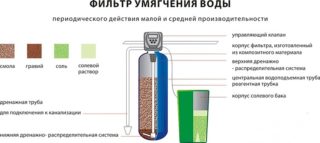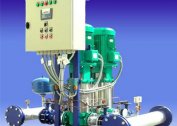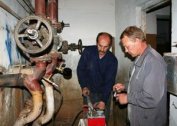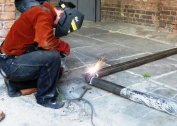Often even tap water is not particularly soft. And resources from autonomous sources (wells, wells) a priori leave much to be desired. Therefore, hard water and methods of softening it become the number one task for owners of suburban areas. There are many ways to combat the increased mineralization of the liquid, and you can choose one for any budget.
The consequences of using hard water
The rigidity of the drinking resource means the totality of the chemical and physical properties of a liquid: the concentration of dissolved salts of magnesium and calcium in it. The higher it is, the harder the water is. If magnesium and calcium carbonates are present in the liquid, such hardness is called carbonate (temporary). When boiling, dissolved salts are released from the liquid. Non-carbonate hardness is the presence in the aquatic environment of sulphates and chlorides of calcium and magnesium. You cannot overcome them with heat treatment.
The main problems that increased water mineralization creates:
- overdried skin and hair, peeling of the dermis, allergic reactions;
- low level of foaming during hygiene or household events (bathing, washing, cleaning);
- the formation of thick layers of scale in household, heating, kitchen appliances (kettle, washing and dishwasher, boiler, heating pipes, etc.); expensive equipment often breaks down due to a raid;
- kidney problems with the constant use of highly mineralized water (urolithiasis);
- aerator and shower head clogged with limescale;
- the presence of white stains on dark washed linen.
The whitish film on the surface of hot coffee or tea does not look very nice either.
Water hardness
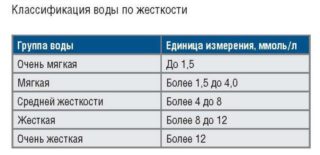 According to SanPiN 2.1.4.1074-01, for the tap water supplied by the central lines, a mineralization index of up to 6 mEq / liter is considered the norm. Although in practice the level of 4-5 mEq / liter already creates a fair amount of problems.
According to SanPiN 2.1.4.1074-01, for the tap water supplied by the central lines, a mineralization index of up to 6 mEq / liter is considered the norm. Although in practice the level of 4-5 mEq / liter already creates a fair amount of problems.
In total, three degrees of mineralization of the liquid are classified:
- soft - up to 3 mEq / liter;
- the average is 3-6 mEq / liter;
- hard - more than 6 mgVeq / liter.
The reasons for the increased mineralization of water from a well or a well are their communication with layers of limestone, dolomites, gypsum, etc.
Methods for determining the level of stiffness
 Residents of apartment buildings and private houses are desirable to know the level of water hardness. This is done for such purposes:
Residents of apartment buildings and private houses are desirable to know the level of water hardness. This is done for such purposes:
- install the right programs for household appliances;
- buy an optimal cartridge for water softening;
- choose the right dosage of emollients;
- provide optimal conditions for aquarium inhabitants;
- choose a reliable and efficient filter system.
You can independently determine the level of mineralization of a liquid in several ways.
Accurate analysis
The collected sample is taken to the local SES. For liquid, you need to choose a clean polymer container. The volume of material for the study is 1-2 liters. The sanitary and epidemiological station will not only determine the concentration of dissolved salts in water, but also detect the presence of pesticides, nitrates, hydrogen sulfide, manganese, iron, and organics. The analysis is especially good for selecting the right filter system or water softener.
Using Test Strips
This is a quick way to determine fluid quality. You can buy indicators at zoological stores or tea and coffee sales outlets. A special reagent applied to the test strip is dyed in a certain color upon contact with dissolved minerals.The color intensity indicates the level of salt concentration in the water, that is, the degree of its hardness. The brighter the color, the more dissolved salts in the available sample.
The highest quality test strips are those made in Europe.
Conducting a home experience
It will require warm distilled water and a piece of laundry soap 72%. From the equipment at hand you need to have a glass, a transparent liter capacity (can a jar), electronic scales and a ruler.
They act during the experiment in this way:
- Soap is rubbed onto a fine grater and 1 gram is measured. The finished mass is dipped in an empty glass.
- Distilled water is heated to 60-70 degrees and poured there. The soap should completely dissolve.
- Still distilled liquid is added to the glass at the rate for soap 72% - 7 cm, for soap 60% - 6 cm.
- 0.5 l of tap (well, well) liquid is loaded into the jar.
- A distilled soapy solution is slowly poured here and everything is stirred until a foam is formed, which indicates that the household soap bound all the mineral salts.
- It remains to measure the height of the liquid below the foam and subtract it from the original level in the bank. This will be the approximate concentration of dissolved minerals in water.
Although this experience is interesting, it does not differ in increased accuracy.
The main methods of water softening
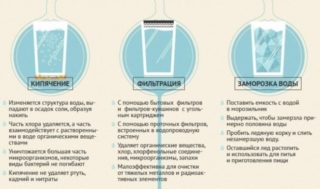 They are looking for different ways to fight against water hardness. In general, there are three methods of processing the liquid - thermal, physical, chemical.
They are looking for different ways to fight against water hardness. In general, there are three methods of processing the liquid - thermal, physical, chemical.
Thermal
Boiling is the easiest way, suitable for a resource with variable mineralization. The bicarbonates of calcium and magnesium decompose, forming a calcium carbonate precipitate and carbon dioxide. The method is good because it can be used at home without buying expensive equipment. But there are two drawbacks - large volumes of liquid cannot be processed, and lime scale will constantly form on the walls of kitchen appliances.
Another method of thermal exposure to hard water is freezing. Here you can use only that liquid which after thawing remains on top.
Physical methods
- Run water through a membrane under high pressure. As a result, only water molecules pass through a kind of barrier, but not particles of salts dissolved in it. The result is the production of practically distilled liquid. It is on this principle that reverse osmosis plants such as the Trickle, Geyser, etc. work. The main advantage of the membrane method is the almost complete purification of the resource not only from salts, but also from other organic and inorganic impurities. The disadvantages of the method include the need for constant high pressure in the system (3-4 atm.), The impressive cost of equipment for softening and additional mineralization of the liquid to make it suitable for use. Otherwise, it is “dead” and carries harm rather than benefit to the body.
- Electromagnetic processing. This method is considered relatively new. Electromagnetic waves of a specific frequency are passed through hard water. This leads to the fact that calcium and magnesium ions become suspended, lose the ability to precipitate. It is in this form that they are removed from the total volume of liquid.
- Hard water treatment by magnetic fields. Here, the principle of conversion of magnesium and calcium ions is similar to exposure to electromagnetic waves. The result - dissolved impurities go into suspension and are removed through filters or into sumps.
Any of the physical methods of water is ideally good for industrial applications, but costly for home use.
Chemical treatment
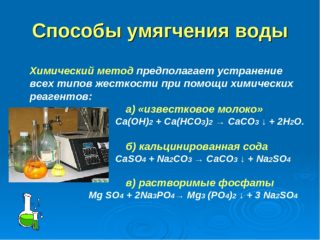 To soften tap (borehole, well) water, various reagents are used. They change the valency of calcium and magnesium, turning them into suspended particles that can precipitate. As such reagents are used:
To soften tap (borehole, well) water, various reagents are used. They change the valency of calcium and magnesium, turning them into suspended particles that can precipitate. As such reagents are used:
- lime;
- soda ash (salt) + salt;
- synthetic splitters;
- sodium chloride (salt) + soda;
- table vinegar (such water is especially good for washing);
- lime + soda;
- special salt to soften the liquid;
- drugs in tablets.
The principle of action of the reagents used is the dissolution of all hard elements or their complete replacement with softer impurities.
The advantages of using reagents include:
- removal of all mineral impurities;
- prevention of scale on household appliances;
- neutralization of muddy stains on linen.
The minuses include:
- the inability to use the treated liquid for food (except for soda and saline solutions);
- the need for knowledge and compliance with dosages of reagents.
As a rule, in everyday life they use simple salt and soda to soften the liquid. For one liter of water, 0.5 teaspoon of the reagent is enough.
To soften the water in the boilers of heating systems also use special filters with polyphosphates. These are peculiar white crystals, which gradually dissolve when liquids pass through them. Thus, they bind metal salts, making the medium softer. The polyphosphate softening method is suitable only for industrial, technical purposes. You can’t drink such water.
Ion exchange method
With this method, hard water passes through special loosened resins that give up their ions and replace them with magnesium and calcium ions. More often, with this method, special settings are used. Resins of the type AMBERJET 1200 Na, AMBERLITE SR 1L, etc. are laid in them.
The disadvantage of this method is that the tab after a certain period of work must be disposed of in accordance with sanitary standards. The advantages of the method include the possibility of processing large volumes of liquid, high quality softening. This is more often an industrial technological process than a domestic one.
The liquid expelled through the ion exchange unit is unsuitable for consumption.
For the home, it is advisable to use combined methods of softening, iron removal of the water resource, based on the use of special diverse filters. They are selected according to the type of pollution and the level of mineralization.

